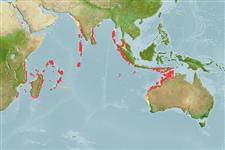Common names from other countries
Environment: milieu / climate zone / depth range / distribution range
Ecologia
marinhas associadas(os) a recifes; intervalo de profundidade 22 - 80 m (Ref. 90102), usually 50 - 68 m (Ref. 9710). Tropical
Western Indian Ocean: known only from Mauritius, Reunion, Madagascar, Amirante, Christmas Island, and Cocos-Keeling Atoll south of Sumatra. Probably widely distributed around the islands of the tropical Indian Ocean.
Tamanho / Peso / Idade
Maturity: Lm ? range ? - ? cm
Max length : 14.0 cm SL macho/indeterminado; (Ref. )
Descrição breve
Chaves de identificação | Morfologia | Morfometria
Espinhos dorsais (total) : 8; Raios dorsais moles (total) : 18 - 20; Espinhos anais: 3; Raios anais moles: 14 - 15.
Not much is known of this deep-dwelling butterfly, but recent observations indicate that it can form small groups of up to 5 individuals and inhabits steep outer reef drop-offs in rubble areas or among growths of black coral and sea fans. Oviparous (Ref. 205). Form pairs during breeding (Ref. 205).
Life cycle and mating behavior
Maturities | Reprodução | Spawnings | Egg(s) | Fecundities | Larvas
Form pairs during breeding (Ref. 205). Monogamous mating is observed as both obligate and social (Ref. 52884).
Allen, G.R., 1985. Butterfly and angelfishes of the world. Vol. 2. 3rd edit. in English. Mergus Publishers, Melle, Germany. (Ref. 4858)
Categoria na Lista Vermelha da IUCN (Ref. 130435)
CITES (Ref. 128078)
Not Evaluated
Ameaça para o homem
Harmless
Utilização humana
Ferramentas
Relatórios especiais
Descarregue XML
Fontes da internet
Estimates based on models
Preferred temperature (Ref.
115969): 24.4 - 26.9, mean 25.8 (based on 18 cells).
Phylogenetic diversity index (Ref.
82804): PD
50 = 0.5000 [Uniqueness, from 0.5 = low to 2.0 = high].
Bayesian length-weight: a=0.02291 (0.01133 - 0.04632), b=3.00 (2.83 - 3.17), in cm Total Length, based on LWR estimates for this Genus-body shape (Ref.
93245).
Nível Trófico (Ref.
69278): 3.5 ±0.37 se; based on food items.
Resiliência (Ref.
120179): Elevada, tempo mínimo de duplicação da população menor que 15 meses (Preliminary K or Fecundity.).
Fishing Vulnerability (Ref.
59153): Low vulnerability (10 of 100).
